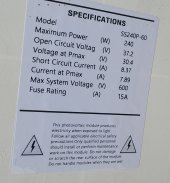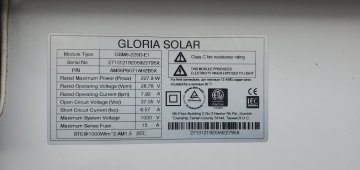73powerstroke
Solar Enthusiast
I'm not sure if I should try to re arrange these panels. But what I have is 4 trina 240w panels and 5 Gloria 225W panels in 3s3p on my hvlv2424. Normally I would need 12 of the 240w trinas to realize the 2000w 80amp input .
These panels are both physically the same size. Each Gloria 225w has different but similar specs. Some say 229w some 227w. With different amps and voc
9 panels under heavy load (1.8kw) made 1.6kw earlier today but I think I might be able to arrange these different where the smaller panels don't drag everything down. I have another 3 more Gloria's for my 12 I would normally need to make the 2kw. I think im losing 30w per panel. The trinas usually do 180w but I think the others are 155w
So we have
Trina voc 37.2 vs 37.05 Gloria
Vpmax 30.4 vs 28.78
Isc. 8.37 vs 8.57
Ipm 7.89 vs 7.92


These panels are both physically the same size. Each Gloria 225w has different but similar specs. Some say 229w some 227w. With different amps and voc
9 panels under heavy load (1.8kw) made 1.6kw earlier today but I think I might be able to arrange these different where the smaller panels don't drag everything down. I have another 3 more Gloria's for my 12 I would normally need to make the 2kw. I think im losing 30w per panel. The trinas usually do 180w but I think the others are 155w
So we have
Trina voc 37.2 vs 37.05 Gloria
Vpmax 30.4 vs 28.78
Isc. 8.37 vs 8.57
Ipm 7.89 vs 7.92





